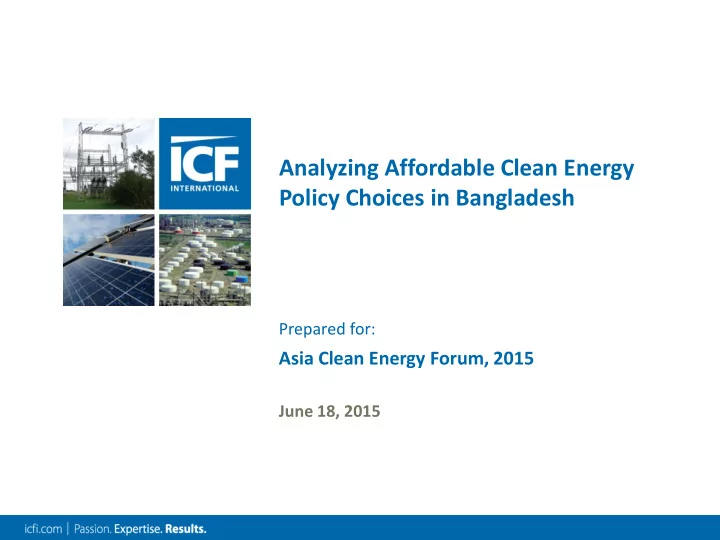

Analyzing Affordable Clean Energy Policy Choices in Bangladesh Prepared for: Asia Clean Energy Forum, 2015 June 18, 2015
Outline • Introduction • Project Background • Need for Energy Policy Analysis • Overview of the Power Sector Modeling Tool • Structure • Process • Analytic Approach • Inputs • Outputs • Application • Results • Conclusion 2
INTRODUCTION Background Catalyzing Clean Energy in Bangladesh (CCEB) – 5-year program (2012-2017), ~US$15 MM, funded by USAID – Goal is to promote clean energy development – 5 areas of support, includes power sector improvements, energy efficiency, and clean cook stoves – Implemented by Deloitte (prime), ICF International (sub) and others – For more information - http://www.cleanenergy-bd.org/ ICF International (www.icfi.com) – Provides professional services and technology solutions; founded in 1969 – World-class domain expertise in energy, environment, transportation, health care, IT – Diverse client base – US Federal, state, local, commercial, international – Over 5,000 employees, ~$1B in revenue – 70 offices worldwide, HQ in Washington, DC metro area 3
INTRODUCTION Need for Energy Policy Analysis Bangladesh faces significant challenges in electricity generation – 10% annual growth rate in electricity demand projected for the foreseeable future – Goal is to provide electricity for all by 2021 Bangladesh also faces significant climatic challenges – IPCC predicts significant loss of landmass due to sea level rise – Severe hit to agriculture due to changes in precipitation Are meeting the needs of both “mutually exclusive”? – Can we improve energy security and physical security simultaneously? Need data and tools to analyze these important questions – Tools created under CCEB are intended to inform these policy questions 4
OVERVIEW Power Sector Policy Analysis Model (PSPAM) Goal is to find mutually consistent energy development scenarios – Options that meet the energy needs while lowering emissions – Added “co - benefit” will be improved air quality (reduced air pollution ) Analyze multiple “what - if” type national -level scenarios – Assumptions about demand growth, fuel mix, power imports, etc. – Bottom-up accounting of power fleet GHG emissions Provides impacts on multiple levels – System costs, fuel requirements, generation mix, power prices, GHG emissions Not a substitute for generation planning tools – Supplements capacity planning needs, with a less rigorous scenario planning model, adequate for high-level policy discussions 5
OVERVIEW PSPAM Development 6
ANALYTICAL APPROACH PSPAM Inputs Scenarios can be created by changing a variety of input parameters – Fuel prices – Technology costs and performance – Electricity demand – Plant efficiency (capacity factors) – Financial assumptions (capital charge rates, exchange rates, etc.) Inputs can be dynamically adjusted to reflect changing national and/or global conditions – Also allows for easy sensitivity analyses – Modeling period extends to 2030, consistent with other GOB modeling (but can be further extended) Model provides flexibility of combining different parameter values for potentially unlimited number of policy scenarios 7
ANALYTICAL APPROACH PSPAM Outputs Results are mostly presented graphically – Easy to compare year-by- year variations Results focus on high-level impacts on power system – Generation types, costs, power prices, CO2 emissions – Goal is to aid in policy discussions, not to “predict” precise impacts 8
ANALYTICAL APPROACH PSPAM Outputs Shows the undiscounted annual and cumulative costs for the scenario analyzed – Provides a quick way to compare costs across scenarios 9
APPLICATION Analyzing Policy Choices with PSPAM Current work focuses on setting up a series of scenarios in consultation with policymakers – Data obtained from various government entities – Data can be updated easily by policymakers in government – Results are mostly illustrative, intended to spur discussions on potential policy options – Important conclusions can be drawn by comparing results across scenarios Both demand and supply side options are being analyzed – Comparing trade-offs between investing in reducing demand vs. building new capacity – Optimum policy choices may include investing in both demand and supply 10
APPLICATION Representative Scenario Results 2030 Results Name of Scenario Generation Cost CO2 Emissions (BDT/kWh) (MMT) 8.4 125 MP fuel diversification with PSMP costs – RC 1 8.83 125 RC with updated fuel costs RC with updated capital costs 8.7 125 9.13 125 Updated RC (fuel costs and capital costs) 9.11 108 Updated RC with demand side options 8.88 105 Updated RC with biomass co-firing for coal plants 8.45 101 Updated RC with liquid fuel replaced with LNG 2 10.36 104 Updated RC with natural gas replaced with LNG 3 8.58 95 Updated RC with cross border promotion Hybrid – Low Hanging Fruit 4 8.94 102 Hybrid – Longer term choices 5 9.30 88 Updated RC with 100% coal 10.04 171 Updated RC with 100% NG 7.84 99 1 PSMP = Power System Master Plan, 2010; RC implies Reference Case 2 Assumes LNG price = $18/MMBtu 3 Assumes LNG price = $14/MMBtu 4 Assumes significant investments in technology upgrades to switch fuel (about one-third of the fuel costs); biomass fuel costs one- third of coal per unit of energy 5 Assumes significantly higher power imports at higher than current costs; increased investments in EE BDT = Bangladesh Taka (US$ 1 = BDT 80) 11
CONCLUSION Choosing Appropriate Policies Potentially promising clean energy options exist for Bangladesh – Choices that can reduce emissions cost effectively – “win - win” Certain options might be relatively easy to implement in short run – Fuel switching from liquid fuel (diesel, furnace oil) to liquefied natural gas (LNG) – Biomass co-firing at existing or new coal generation – Increasing cross border power imports under current arrangements (power purchase agreement) Some choices may require more long term view but are still effective in reducing emissions at comparable costs – Reducing load growth through electricity demand reduction measures – Investing in significantly higher power imports (e.g., investing in tapping hydro resources in Nepal, Bhutan) 12
Questions? Bansari Saha +1-617-250-4286 Bansari.Saha@icfi.com
Recommend
More recommend